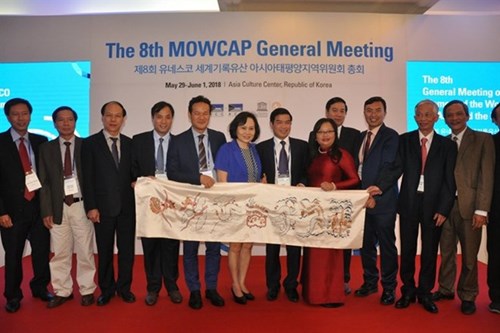    |
 |
|
The Vietnamese delegates were proud when the documents were recognized as a Memory of the World. Photo courtesy of Chu Thu Phuong |
The eighth meeting of MOWCAP took place on May 29-31 in Gwangju, the Republic of Korea, attracting 125 representatives from 28 countries.
The panel considered 12 dossiers from eight countries including Tuvalu, Myanmar, China, the Philippines, South Korea, Australia, the Solomon Islands and Vietnam.
Hoang Hoa Su Trinh Do (The Envoyship Journeys to China - literally translated as maps and itinerary of the envoy’s journey to China) belonged to the Nguyen Huy family in the Central province of Ha Tinh.
With writings, drawings and maps, the book recorded the diplomatic relationship between Vietnam and China in the 18th century through journeys of Vietnamese envoys. It was compiled and edited by Nguyen Huy Oanh (1713-1789) based on documents of previous envoys and historical records as well as notes from his own journey in 1766-1767, during which he worked as the main envoy of the Vietnamese delegates.
Chu Thu Phuong, a member of the Vietnamese delegation at the meeting, said the panel appreciated that the book is a rare and precious document relating to the diplomatic relationship between Vietnam and China since the feudal era. The friendship between the two countries played an important role in maintaining peace in the region and the world.
The dossier of the book received 17 votes from 17 members of the panel. It meets all the criteria to be recognized as a documentary heritage of the Memory of the World program.
The Memory of the World Program is an international program aimed at safeguarding, preserving and facilitating access to and the use of documentary heritage. UNESCO launched the program in 1992. It includes the inscription of significant documentary heritage on national, regional and international registers.
MOWCAP was set up in 1998 and is the regional forum for UNESCO’s global Memory of the World (MOW) Program. MOWCAP aims to assist with the preservation of and universal access to documentary heritage of the Asia Pacific region, and also to increase awareness of the existence and significance of the heritage.
Source: VNA